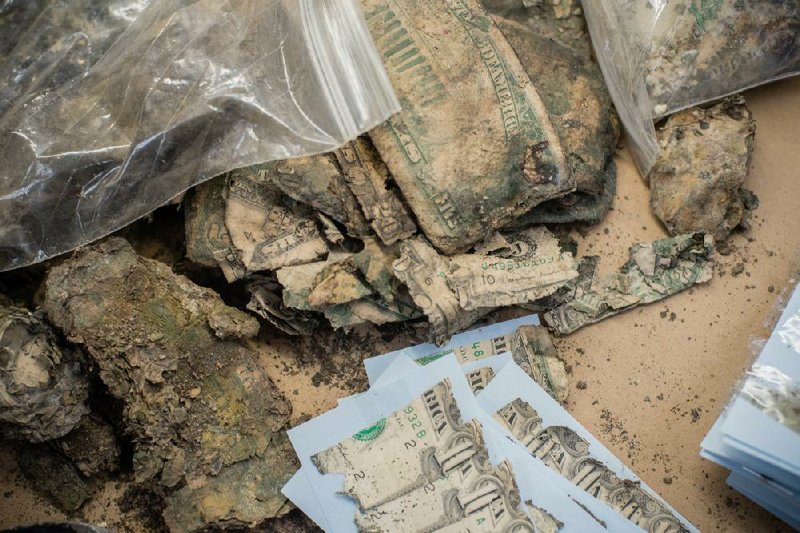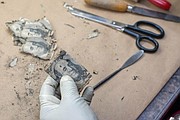WASHINGTON -- Gao E. Freeman presses a piece of tape into a clump of material that looks like the gunk you might find on the bottom of your boot after a muddy hike. With a scalpel, he carefully loosens and lifts a thin layer and attaches it to a pale blue index card. He repeats this process four times. In minutes, he has enough evidence to identify the fragments as five $20 bills. The amount is a mere drop in a bucket -- or, in this case, a plastic bag -- that may have contained $150,000. But it's a promising drop nonetheless.
Freeman is one of a dozen examiners with the Mutilated Currency Division of the Treasury Department's Bureau of Engraving and Printing. These experts play forensic scientist with damaged bank notes. It could be called "CSI: Currency Victims Unit." They inspect an owner's unusable money to determine a value, which the Treasury Department will redeem in check form.
Every week, the federal office in Washington receives hundreds of padded envelopes, boxes and even safes stuffed with cash ravaged by water, fire, shredding machines, insects or a canine's teeth. "Your dog ate your money. Your grandma buried $100,000 in her backyard. Your 2-year-old shredded an envelope filled with $1,000," says program manager Ty Hensell. "Look it up on YouTube," he instructs, referring to the last scenario, a well-publicized event from October 2018.
The examiners, who worked on 23,600 cases in 2019, try to salvage as many bills as possible. The more they can piece together, the larger the reimbursement check. Last year, the agency issued checks for more than $35 million to businesses and individuals who had submitted their battered money, hoping to recoup some or all of its value. "We only redeem on what we can validate and authenticate," not what someone claims they lost, says Lydia Washington, lead public affairs specialist with the bureau.
This free public service dates from 1862, when the U.S. government introduced a national currency. The office accepts all U.S. bank notes, including such discontinued denominations as $500, $1,000, $5,000 and $10,000. It doesn't redeem mangled coins or despoiled collectibles, such as Confederate dollars.
To consider a claim, the office needs the mutilated currency, regardless of its condition or odor. "After Hurricane Katrina, the money had a horrible stench to it," Hensell said. Claimants must also provide a letter explaining how the money got damaged, the amount being claimed and full contact information. The office plans to introduce an online claims system by the end of the year.
Mutilated cash should be treated as if it were a body in a crime scene, Washington said. Leave it as intact as possible, unless it has been exposed to a toxin or other impurities. "If it's got dog poo or blood on it, clean it off," Washington said. "Or let us know if it's been contaminated." All of the work stations come with environmental HVAC systems and protective gear including gloves, masks and goggles.
Each case earns a ranking. One is lowest in amount and effort, such as a dollar torn in half; 5 is the highest, like Freeman's morning project, which involved a Pennsylvania basement, a flood and a sack of cash. Asked for an example of a challenging assignment from his 18-year career, he responds, "This one."
This mid-January morning, nearly everyone on the floor has a tough case. Barbara Gray delves into a yellow shoe box that, according to the enclosed note, contained $600,000. The owner had buried the wad in a backyard in Argentina. "They thought it was a safe place," she says. It wasn't. After so much time underground, the stacks of cash resemble briquettes after a cookout. Gray uses a pair of scissors to excise the image of Benjamin Franklin from several bills. Six eyes gaze up at her. That's $300 so far.
To discourage fraudsters who might try to redeem the same notes twice, the office has safeguards: A bank note counts only if more than half of it is discernible (so don't try sending in the other 49% at a later date) or if it's in total ruins. The staff also attends training sessions led by the Secret Service to learn how to spot counterfeit currency. Submission of such currency is rare, but it happens.
When natural disasters strike, there's an influx of submissions from the affected area: New Orleans after Katrina, Houston after Hurricane Harvey, Sonoma County after the California wildfires. "Burn is the worst," says examiner Tina Barnett.
The 2018 California wildfire was the culprit in the case Ronald Livingston is scrutinizing. He peels the charred remains off a roll plucked from a tin container recovered from a burning car. With a brush, he sweeps the blackened bits aside. "These are all twenties," he says.
On occasion, folks will receive payment for less than their estimate. Other times, the recipient will reap a windfall as unexpected as Ed McMahon showing up with a Publishers Clearing House check.
Barnett, a 20-year employee, shares the bittersweet story of a son who, after his father died, discovered water-damaged money in the garage. He guessed it was $50,000. Barnett counted $400,000.
SundayMonday on 02/23/2020

